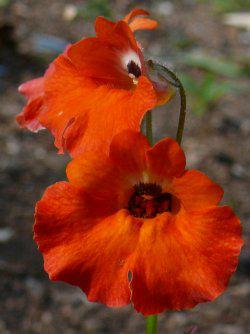Nemesia strumosa
Nemesia strumosa (Herb. Banks ex Benth.) Benth.
Family: Scrophulariaceae
Common names: nemesia (Eng.), balsa mienie, leeubekkie, rooileeubekkie (Afr.)
Introduction
This striking annual comes in yellow, orange, pink, cream, red, mauve or white, and on its own it is capable of creating a riot of colours so typical of the Namaqualand landscape. It is therefore well-suited to the sunny small garden, pots and larger gardens alike. But whatever the location, be prepared for a rich explosion of colours.

Description
Description
Nemesia strumosa is an annual of up to 40 cm. It occasionally branches from the base. The opposite leaves are narrow and slightly toothed. Flowers appear in a compact cluster and are two-lipped and pouched at the base. Colour varies from white, cream, pink, yellow, mauve and red to orange, with dark marks in the throat. The throat is coarsely hairy. Flowering is from September to October.

Conservation Status
Status
This nemesia has a current status of Near Threatened (NT). It is estimated that this annual species has lost over 80% of its habitat to wheat cultivation. This decline is continuing, due to alien plant invasion and coastal development.
Distribution and habitat
Distribution description
Nemesia strumosa is found on sandy flats from Hopefield to Melkbos, north of the Cape Peninsula.

Derivation of name and historical aspects
History
The genus name Nemesia is derived from the Greek name nemesion for a plant similar to these herbs. The specific epithet strumosa means to have cushion-like swellings.
Approximately 60 species of Nemesia are found in southern Africa.
It is one of the South African annuals which has been in cultivation for a long time. Lighton (1973) reports that Hildagonda Duckitt sent seed to Suttons in England in 1890. They started marketing the seeds in a range of colours in 1893 and it has remained popular ever since. Miss Duckitt so liked the plant that her house in Wynberg was called Nemesia Cottage.
Ecology
Ecology
The seed is extremely light and is dispersed by the wind. It is not known whether any insects assist with any pollination.

Uses
Use
No medicinal or cultural uses have so far been reported. It is an amazing landscaping species and as such it is useful in small to larger gardens and pots.
Growing Nemesia strumosa
Grow
Sow the seed of Nemesia strumosa during early autumn using a well-draining medium, and place in a sunny position. Level the medium and then sow the light seeds evenly on a windless day (if outside), water gently and cover with a thin layer of sand or bark. The seed will germinate within the first two to three weeks.
Prick seedlings out from the beds or trays as soon as they are large enough to be handled.
It is sometimes required that the compacted soil in the flowering bed be loosened up and aerated. Organic fertilizer and well-rotted compost can also be added; use a rotovator or fork to work it into the soil. Level the soil out by using an iron rake. Plant the seedlings close together.
Flowering starts during August right through towards October. Seed will be ready for harvesting from September onwards.
Nemesia strumosa is ideal for mass plantings or mixed plantings with other annual species in small or larger flower beds. It also performs well in pots. There are various other annuals which either occur with this species in its natural habitat or which have been found to complement it rather well. These include: Ursinia anthemoides (marigold), U. cakilefolia and U. speciosa (Namaqua-ursinia), Senecio elegans (wild cineraria), Dorotheanthus bellidiformis (Livingstone daisy), Heliophila coronopifolia (blue flax), Dimorphotheca pluvialis (white Namaqualand daisy) and Dimorphotheca sinuata (Namaqualand daisy).
References
- Goldblatt, P. & Manning, J. 2000. Cape plants. A conspectus of the Cape flora of South Africa. Strelitzia 9. National Botanical Institute, Pretoria & Missouri Botanical Garden, Missouri.
- Lighton,C. 1973. Cape Floral Kingdom. Juta, Cape Town.
- Manning, J. & Goldblatt, P. 1996. West Coast : South African Flowering Guide 6. Botanical Society of South Africa, Cape Town.
- Powrie, F. 1998. Grow South African plants . A gardener's companion to indigenous plants. National Botanical Institute, Cape Town.
- Raimondo, D., Von Staden, L., Foden, W., Victor, J.E., Helme, N.A., Turner, R.C., Kamundi, D.A. & Manyama, P.A. (eds). 2009. Red list of South African plants 2009. Strelitzia 25. South African National Biodiversity Institute, Pretoria.
- Stearn, W. 2002. Stearn's dictionary of plant names for gardeners .Timber Press. Portland, Oregon.
Credits
Roger Oliver
Kirstenbosch NBG
October 2012
Plant Attributes:
Plant Type: Bi/Annual
SA Distribution: Western Cape
Soil type: Sandy, Loam
Flowering season: Spring, Winter
PH: Neutral
Flower colour: Red, White, Pink, Cream, Yellow, Orange
Aspect: Full Sun
Gardening skill: Easy
Special Features:
Horticultural zones











Rate this article
Article well written and informative
Rate this plant
Is this an interesting plant?
Login to add your Comment
Back to topNot registered yet? Click here to register.